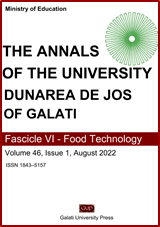Impact of drying method on bioactive compounds, functional and thermal properties of durum wheat (Triticum durum) sprouts
Abstract
Sprouting is recognized as a green engineering tool for improving cereal's nutritional properties. Thus, the incorporation of sprouts in food formulation would be recommended. However, sprouting also increases the seeds’ water content which shortens their shelf life. Thus, drying is recommended to decrease moisture content. This research aimed to investigate the impact of different drying methods (Oven drying, lyophilization and micro-wave vacuum drying (MVD)) on durum wheat sprout's bioactive compounds, physicochemical, functional and thermal properties through differential scanning calorimetry (DSC). Durum wheat was sprouted for 48h, then water content, water activity (aw), color, bulk density, Water Absorption Capacity (WAC), Oil Absorption Capacity (OAC), Swelling Power (SP), Least Gelation Concentration (LGC) and thermal properties through DSC were assessed for raw and dried sprouts. Sprouting and drying significantly affected the evolution of all properties. In all cases, water content and aw decreased to an acceptable level. Oven and MVD dried samples were darker than freeze-dried ones. Compared to the raw samples, bulk density and SP decreased while OAC increased. WAC decreased after lyophilization (-14.3%) while it significantly increased (+90.5%) after MVD. DSC measurement showed two endotherms with peak temperatures between 39.7 and 46.6 °C for the first and 101.9 to 108.5 °C for the second. Regarding nutritional properties, lyophilization preserved them the best. However, MVD induced lower losses than oven drying. Understanding changes occurring after drying would help choose the suitable drying technology and better use dried sprouts after knowing their properties.


